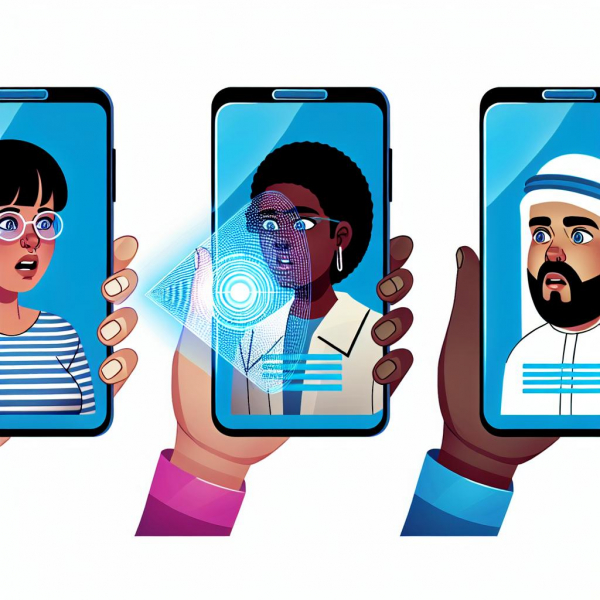Step into a world where the boundaries between reality and imagination become delightfully blurred. Welcome to the realm of Augmented Reality (AR) in mobile app development, where innovation knows no limits. As the rise of smartphones continues to shape our daily lives, technology marches forward hand in hand, trembling with excitement to unveil the captivating possibilities of AR. This bewitching marriage of the virtual and real opens doors to a universe brimming with limitless potential, inviting developers and users alike to witness the marvels that await. Delve into this enchanting article as we unravel the captivating tapestry that is the use of AR in mobile app development.
Table of Contents
- Exploring the Boundaries of Imagination: The Impact of AR in Mobile App Development
- Unleashing the Potential: How AR Transforms User Experience in Mobile Apps
- Taking Mobile App Development Beyond Reality: Harnessing the Power of AR
- Revolutionizing Mobile App Development: Leveraging AR for Enhanced Interactivity
- A Welcoming Path to Innovation: Incorporating AR Techniques in Mobile App Development
- Optimizing Mobile App Performance: Key Considerations for Integrating AR Technology
- Transforming the User Interface: Designing Intuitive AR Experiences for Mobile Apps
- Q&A
- The Conclusion

Exploring the Boundaries of Imagination: The Impact of AR in Mobile App Development
Augmented reality (AR) technology has revolutionized the mobile app development industry, opening up a whole new world of possibilities. The integration of AR has given developers the ability to merge the virtual and physical worlds, enhancing user experiences like never before. With the advancement of AR capabilities in mobile devices, developers are not only limited to creating games or fun filters anymore. Instead, they can create immersive and interactive apps that serve various purposes, from education and training to marketing and entertainment.
The use of AR in mobile app development has brought numerous advantages and benefits. Firstly, it offers a unique and engaging way for users to interact with content. Rather than passively consuming information, users can now actively participate and explore virtual objects and environments. This interactive element adds a level of excitement and innovation to mobile apps, making them more memorable and captivating for the users. Additionally, AR can provide real-time information and assistance, enhancing productivity and efficiency in various industries. For example, retail apps can utilize AR to allow customers to virtually try on clothes or visualize products in their own homes before making a purchase.

Unleashing the Potential: How AR Transforms User Experience in Mobile Apps
Augmented Reality (AR) has revolutionized the world of mobile app development, bringing a whole new level of interactive experience to users. With AR, developers can integrate virtual elements into the real world, enhancing user engagement and transforming the way we interact with mobile apps.
One of the key advantages of using AR in mobile app development is its ability to provide users with a more immersive and realistic experience. By overlaying digital content onto the physical world, AR creates a seamless integration between the virtual and real environments. This opens up a world of possibilities for app developers, allowing them to create interactive 3D models, lifelike animations, and interactive games that react to the user’s surroundings.

Taking Mobile App Development Beyond Reality: Harnessing the Power of AR
In the ever-evolving world of mobile app development, augmented reality (AR) has emerged as a game-changing technology. AR blends the real world with digital elements, creating an immersive and interactive user experience. The use of AR in mobile app development has opened up a world of possibilities, allowing developers to create cutting-edge applications that go beyond reality.
One of the key benefits of incorporating AR into mobile apps is the ability to provide users with a unique and engaging experience. With AR, developers can overlay digital content onto the real world, enhancing the user’s perception and interaction with their surroundings. Whether it’s placing virtual furniture in a room to visualize how it will look or guiding users through a new city with interactive maps and directions, AR brings a new level of interactivity and realism to mobile apps.
Furthermore, AR has become increasingly popular in industries such as gaming, entertainment, and education. Mobile games are now integrating AR features, allowing users to immerse themselves in a virtual world that seamlessly blends with their surroundings. By leveraging AR, educational apps can provide interactive and immersive lessons, making learning more engaging and effective. Additionally, AR has opened up new avenues for businesses to showcase their products and services in a more interactive and captivating way, creating unique marketing opportunities.
In conclusion, the use of AR in mobile app development has revolutionized the way we interact with digital content. By harnessing the power of AR, developers can create apps that break the boundaries of reality, providing users with unforgettable experiences. From gaming to education to marketing, AR has the potential to transform various industries and shape the future of mobile app development. So, get ready to step into a world where reality and imagination blend seamlessly – the world of AR-powered mobile apps.
Revolutionizing Mobile App Development: Leveraging AR for Enhanced Interactivity
Augmented Reality (AR) has emerged as a game-changing technology, transforming the way we perceive the world around us. Its integration into mobile app development has opened up endless possibilities for enhanced interactivity and user engagement. By seamlessly blending virtual elements with the real world, AR creates captivating and immersive experiences that were once thought to be limited to science fiction.
One of the key areas where AR is making a profound impact is in mobile app development. With AR, developers can create applications that overlay digital information onto the user’s view of the physical world. This technology has revolutionized various industries, ranging from gaming and marketing to education and healthcare. Brands can now leverage AR to provide users with interactive experiences, allowing them to visualize products in a virtual environment before making a purchase. The potential for enhancing customer engagement and driving sales is enormous.
A Welcoming Path to Innovation: Incorporating AR Techniques in Mobile App Development
When it comes to mobile app development, innovation is key. Incorporating augmented reality (AR) techniques into app development provides an exciting and interactive user experience that sets your app apart from the rest. AR technology overlays digital information onto the real world, creating an immersive and engaging environment. By leveraging AR in mobile app development, you can revolutionize the way users interact with your app and offer them a unique and memorable experience.
One of the key benefits of using AR in mobile app development is its ability to enhance the user’s perception of reality. With AR, you can seamlessly blend the virtual and physical worlds, allowing users to interact with digital objects in real-time. This opens up countless possibilities for gaming, education, entertainment, and more. Whether it’s overlaying virtual furniture on a real room to help users visualize their home decor choices or integrating AR into a fitness app to provide real-time workout guidance, the potential applications of AR in mobile app development are vast.
Optimizing Mobile App Performance: Key Considerations for Integrating AR Technology
With the increasing popularity of augmented reality (AR) technology, integrating AR into mobile app development has become a powerful tool for enhancing user experiences. However, optimizing mobile app performance when incorporating AR features requires careful consideration of various key factors.
One crucial consideration is the device’s hardware capabilities. AR technology heavily relies on the device’s processing power, graphics capabilities, and memory. Developers must ensure that the app is optimized to run smoothly on different devices, from high-end smartphones to budget-friendly options. By optimizing the app’s performance for various hardware configurations, users can enjoy a seamless AR experience regardless of the device they are using.
Another important factor to consider is the app’s overall performance and responsiveness. AR applications involve rendering intricate 3D graphics and real-time interactions. To ensure smooth performance, developers need to prioritize optimization techniques, such as efficient rendering algorithms, culling techniques, and advanced memory management. Additionally, minimizing latency and maximizing responsiveness are crucial for delivering a real-time AR experience that feels natural and immersive to the user. By implementing strategies like background optimization, data caching, and preloading, developers can minimize lag and latency, enabling users to interact with AR content seamlessly.
In summary, integrating AR technology into mobile app development offers tremendous potential for creating innovative and engaging user experiences. To optimize mobile app performance when utilizing AR features, developers must consider the device’s hardware capabilities and implement strategies to enhance overall performance and responsiveness. Taking these key considerations into account will help ensure the success of AR-driven mobile applications.
Transforming the User Interface: Designing Intuitive AR Experiences for Mobile Apps
Augmented Reality (AR) has quickly become one of the most exciting and innovative technologies in mobile app development. With the ability to overlay digital information onto the real world, AR opens up endless possibilities for enhancing user experiences. In this post, we will explore how the use of AR can truly transform the user interface, making mobile apps more intuitive and immersive than ever before.
1. Enhanced Visual Cues: AR allows developers to incorporate visual cues directly into the physical environment, providing users with helpful hints and guidance. By overlaying arrows, symbols, or text onto real-world objects, users can easily understand and navigate through an app’s features and functionalities with ease.
2. Interactive 3D Objects: Through AR, mobile apps can bring static content to life by integrating interactive 3D objects into the user interface. Whether it’s a product model, a game character, or a virtual tour, these realistic and interactive elements engage users on a whole new level, creating memorable and captivating experiences.
| Benefits of AR in Mobile App Development | Examples |
|---|---|
| Increased engagement | Gamification elements in educational apps |
| Improved user retention | AR-powered shopping apps with virtual try-on features |
| Enhanced understanding of complex information | AR medical apps for visualizing anatomy |
With the increasing popularity of AR technology, incorporating intuitive AR experiences into mobile apps has become a fantastic way to captivate users and provide them with a whole new level of interaction. By leveraging visual cues and interactive 3D objects, developers can create engaging and immersive experiences that enhance the overall user interface. The result? A mobile app that not only stands out from the competition but also keeps users coming back for more.
Q&A
Q: What is augmented reality (AR) and how does it work in mobile app development?
A: Augmented reality is a technology that superimposes virtual objects or information onto the real world environment. In mobile app development, AR utilizes the device’s camera and sensors to overlay digital content, creating an interactive and immersive user experience.
Q: How can augmented reality enhance mobile app development?
A: AR opens up new possibilities in mobile app development by blending the virtual and physical worlds. It allows developers to create apps that enhance the user’s reality with interactive objects, 3D models, animations, and information overlays. This technology offers a unique and engaging way for users to interact with apps and their surrounding environments.
Q: What are some popular use cases of augmented reality in mobile app development?
A: The use of AR in mobile app development has gained popularity in various fields. Some popular use cases include gaming, where AR brings virtual characters or objects into the real world, interior design apps that allow users to visualize furniture in their homes, educational apps that offer interactive learning experiences, and even shopping apps that enable virtual try-on of clothes or accessories.
Q: How does augmented reality impact user engagement and retention in mobile app development?
A: Augmented reality significantly enhances user engagement and boosts retention rates in mobile app development. By providing a more immersive and interactive experience, AR apps captivate users and encourage them to spend more time within the app. This increased engagement leads to higher retention rates as users keep coming back to explore the unique AR features and content.
Q: What challenges do developers face when incorporating augmented reality into mobile app development?
A: While augmented reality presents exciting opportunities, there are several challenges developers face when integrating AR into mobile app development. These challenges include ensuring smooth performance, handling complex 3D models, optimizing battery usage, and providing accurate real-time tracking. Additionally, the variety of devices and their hardware capabilities can also present compatibility issues for developers.
Q: What is the future of augmented reality in mobile app development?
A: The future of augmented reality in mobile app development looks incredibly promising. With advancements in technology and hardware, we can anticipate even more seamless and immersive AR experiences. As AR becomes more widely adopted and integrated into everyday life, we can expect to see revolutionary developments in fields such as healthcare, retail, travel, and beyond. Augmented reality is set to reshape the way we interact with mobile apps and the world around us.
The Conclusion
In a world where technology continues to push the boundaries of what we thought was possible, Augmented Reality (AR) has emerged as a game-changing tool in the realm of mobile app development. With its ability to seamlessly blend the real world with virtual elements, AR has revolutionized the way we interact with our smartphones.
As we bid farewell to this exploration of the use of AR in mobile app development, we can’t help but marvel at the endless possibilities it holds for the future. From enhancing gaming experiences to transforming education, AR has the power to transport us to unimaginable realms where the line between what is real and what is virtual becomes blurred.
AR-powered mobile apps have not only captivated our senses but also opened doors to new business opportunities, allowing companies to engage with their customers in ways previously unimaginable. From trying on virtual clothes before making a purchase to virtually placing furniture in a room to see how it fits, AR has become an indispensable tool for retailers and e-commerce platforms in providing immersive and interactive experiences to their customers.
But it’s not just the retail sector that has embraced the wonders of AR in mobile app development. Industries such as healthcare, architecture, tourism, and entertainment are tapping into its potential to revolutionize the way they deliver their products and services. Whether it’s assisting surgeons in visualizing complex procedures or guiding tourists through historical sites with detailed overlays, AR has proven to bridge the gap between imagination and reality.
As we conclude this article, it becomes evident that AR has not only changed the way we develop mobile apps but has also transformed the way we interact with the world around us. Its ability to blur the lines between fantasy and reality has awakened a new era of possibilities, where our smartphones evolve into gateways to alternate dimensions.
As we look ahead, one thing is certain – the future of mobile app development is irrevocably intertwined with the magic of augmented reality. So let us embrace this extraordinary technology and embark on a journey where imagination is set free, and the limits of what we can achieve are yet to be discovered. The world of AR in mobile app development awaits us, and the adventure has only just begun.
